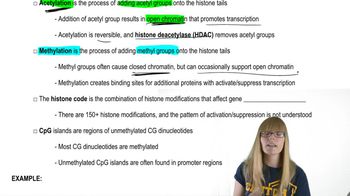Table of contents
- 1. Introduction to Genetics51m
- 2. Mendel's Laws of Inheritance3h 37m
- 3. Extensions to Mendelian Inheritance2h 41m
- 4. Genetic Mapping and Linkage2h 28m
- 5. Genetics of Bacteria and Viruses1h 21m
- 6. Chromosomal Variation1h 48m
- 7. DNA and Chromosome Structure56m
- 8. DNA Replication1h 10m
- 9. Mitosis and Meiosis1h 34m
- 10. Transcription1h 0m
- 11. Translation58m
- 12. Gene Regulation in Prokaryotes1h 19m
- 13. Gene Regulation in Eukaryotes44m
- 14. Genetic Control of Development44m
- 15. Genomes and Genomics1h 50m
- 16. Transposable Elements47m
- 17. Mutation, Repair, and Recombination1h 6m
- 18. Molecular Genetic Tools19m
- 19. Cancer Genetics29m
- 20. Quantitative Genetics1h 26m
- 21. Population Genetics50m
- 22. Evolutionary Genetics29m
13. Gene Regulation in Eukaryotes
Epigenetics, Chromatin Modifications, and Regulation
Problem 13c
Textbook Question
Describe the manner in which activators and repressors influence the rate of transcription initiation. How might chromatin structure be involved in such regulation?
 Verified step by step guidance
Verified step by step guidance1
<span>Step 1: Understand the role of activators in transcription initiation. Activators are proteins that bind to specific DNA sequences known as enhancers. By binding to these sequences, activators increase the rate of transcription initiation by facilitating the assembly of the transcription machinery at the promoter region.</span>
<span>Step 2: Explore the function of repressors in transcription initiation. Repressors are proteins that bind to specific DNA sequences called silencers. When bound, repressors can decrease the rate of transcription initiation by blocking the binding of activators or the transcription machinery to the promoter.</span>
<span>Step 3: Examine the interaction between activators, repressors, and the transcription machinery. Activators and repressors can influence the recruitment and assembly of the transcription machinery, including RNA polymerase and general transcription factors, at the promoter region, thereby modulating transcription initiation rates.</span>
<span>Step 4: Consider the role of chromatin structure in transcription regulation. Chromatin can exist in a condensed form (heterochromatin) or a relaxed form (euchromatin). The structure of chromatin can influence the accessibility of DNA to transcription factors and the transcription machinery, thus affecting transcription initiation.</span>
<span>Step 5: Analyze how chromatin remodeling complexes and histone modifications can alter chromatin structure. These processes can lead to changes in chromatin accessibility, allowing activators and repressors to bind to their respective DNA sequences and regulate transcription initiation effectively.</span>
Recommended similar problem, with video answer:
 Verified Solution
Verified SolutionThis video solution was recommended by our tutors as helpful for the problem above
Video duration:
1mPlay a video:
Was this helpful?
Key Concepts
Here are the essential concepts you must grasp in order to answer the question correctly.
Transcription Factors
Transcription factors are proteins that bind to specific DNA sequences to regulate the transcription of genes. Activators enhance the binding of RNA polymerase to the promoter region, increasing transcription rates, while repressors inhibit this process, leading to decreased transcription. Understanding their roles is crucial for grasping how gene expression is controlled.
Recommended video:
Guided course

Eukaryotic Transcription
Chromatin Structure
Chromatin structure refers to the organization of DNA and histone proteins in the nucleus, which can be either tightly packed (heterochromatin) or loosely packed (euchromatin). This structure influences gene accessibility; when chromatin is more open, transcription factors can more easily access DNA, facilitating transcription. Conversely, tightly packed chromatin can hinder transcription factor binding and gene expression.
Recommended video:
Guided course

Chromatin
Gene Regulation
Gene regulation encompasses the mechanisms that control the timing and amount of gene expression. It involves various elements, including transcription factors, chromatin modifications, and epigenetic changes. By understanding how activators and repressors interact with chromatin, one can appreciate the complexity of gene regulation and its impact on cellular function and development.
Recommended video:
Guided course

Review of Regulation





